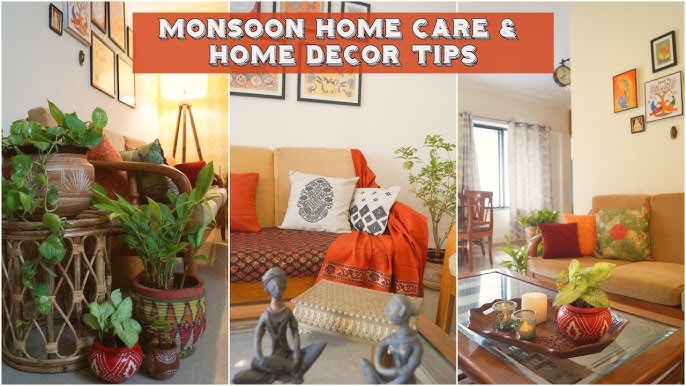Creating a monsoon-proof decor requires a combination of aesthetic appeal and practical measures to withstand humidity, rain, and potential water damage. Here are detailed tips to help you achieve a stylish yet resilient monsoon-ready home:
1. Choose the Right Materials
-
Water-Resistant Fabrics: Opt for synthetic fabrics like polyester, nylon, or treated cotton that resist moisture and mold. Avoid heavy, absorbent fabrics like silk or untreated cotton.
-
Outdoor-Grade Furniture: If you're using furniture in open areas, choose materials like aluminum, teak, or synthetic rattan that are durable and resistant to rust and rot.
-
Non-Absorbent Rugs: Use rugs made from materials like polypropylene or outdoor rugs that can withstand moisture and are easy to clean.
2. Color and Patterns
-
Light Colors: Choose lighter shades for walls and larger furniture pieces, as they help in reflecting light and don’t show moisture stains as easily.
-
Bold Patterns: Use vibrant patterns that can disguise minor stains or wear, perfect for areas prone to spills or splashes.
3. Ventilation and Airflow
-
Windows and Screens: Ensure windows can be opened for airflow. Install screens to keep insects out while allowing fresh air in.
-
Ceiling Fans: Install ceiling fans to improve air circulation and reduce humidity buildup, preventing mold growth.
4. Smart Storage Solutions
-
Waterproof Storage Bins: Store cushions, throws, and other textiles in waterproof bins or containers to protect them from moisture when not in use.
-
Elevated Furniture: Use furniture that is raised off the ground to prevent water damage during heavy rain and make cleaning easier.
5. Indoor Plants
-
Humidity-Resistant Plants: Choose plants that thrive in high humidity, such as peace lilies or snake plants, which also improve air quality.
-
Proper Drainage: Use pots with drainage holes to prevent water accumulation. Consider placing saucers beneath pots to catch excess water.
| "BEST BUILDERS FLOOR APARTMNETS IN CHENNAI" |
6. Wall Treatments
-
Water-Resistant Paints: Use semi-gloss or satin finishes that repel moisture better than flat paints. Consider anti-mold paints for areas prone to dampness.
-
Wall Panels: Use treated wood or synthetic wall panels that can withstand humidity, or opt for tile in bathrooms and kitchens.
7. Lighting Solutions
-
Moisture-Resistant Fixtures: Install light fixtures that are rated for damp environments, especially in bathrooms and kitchens.
-
Natural Light: Maximize natural light through large windows to reduce the need for artificial lighting and help in drying out any dampness.
8. Textile Management
-
Quick-Dry Cushions: Use quick-drying cushion covers and throws made from water-resistant materials for outdoor furniture.
-
Regular Maintenance: Wash and air-dry textiles frequently to prevent mildew. Rotate items to ensure even exposure to air.
9. Create a Monsoon Entryway
-
Mudroom or Entryway Rugs: Use washable rugs at entry points to catch water and mud from shoes. Choose materials that can withstand frequent washing.
-
Coat Hooks and Storage: Install hooks for wet umbrellas and jackets, and provide a designated spot for shoes to keep them dry.
10. Seasonal Adjustments
-
Rotate Decor Items: Store or replace decor items that can’t withstand moisture during the monsoon. Consider seasonal decor that complements the rainy ambiance.
-
Use Decorative Trays: Keep small items on decorative trays to prevent water damage and make cleanup easier.
By carefully selecting materials and planning your decor with the monsoon in mind, you can create a stylish, functional space that withstands the challenges of the rainy season while still looking great!
Also read: Innovations Techniques for your Home
https://www.livehomes.in/blogs













